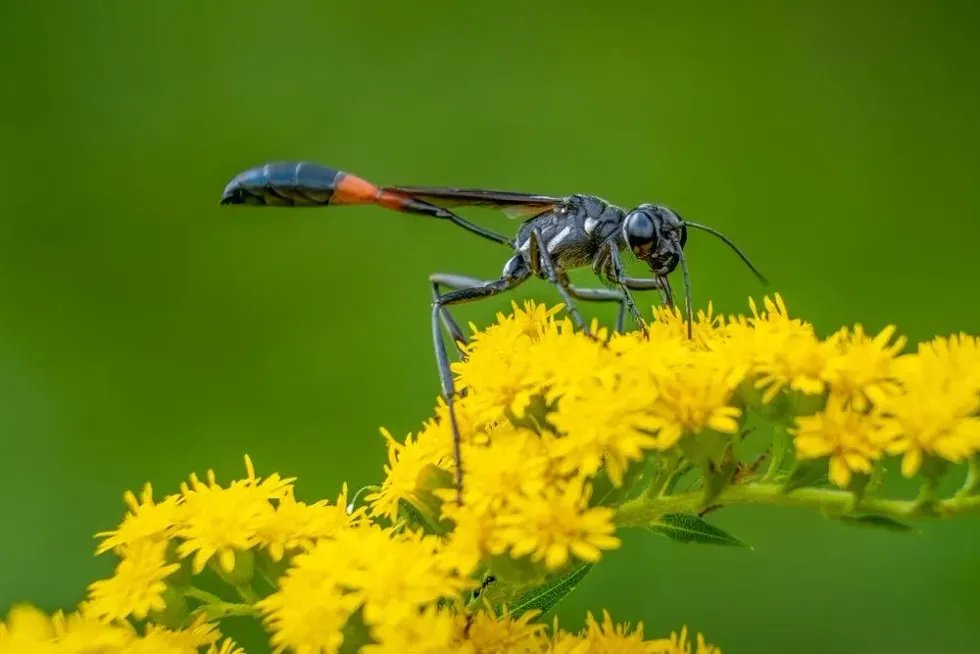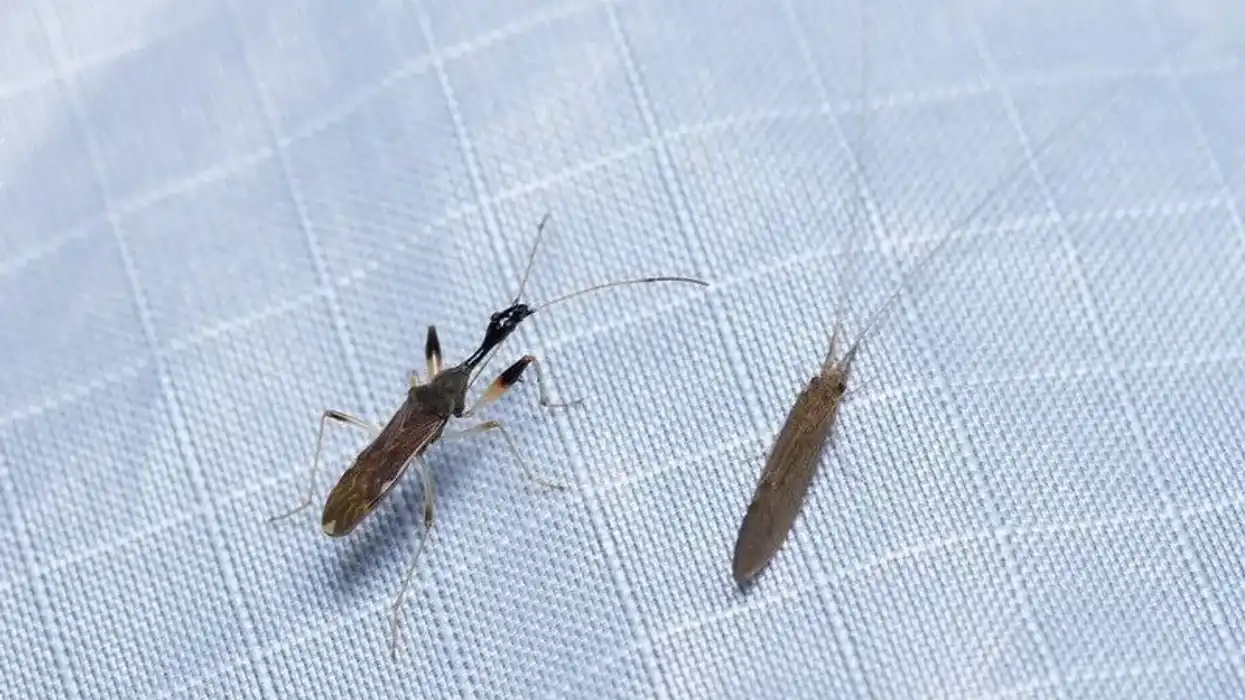The common thread-waisted wasp belongs to the family Sphecidae which includes mud daubers, sand wasps, and other thread-waisted wasps.
These species have an upper body consisting of a thorax and a narrow hair-thin waist which is responsible for the name given to them, with a glossy and bulging abdomen with a red or orange band on it.
This species has black skinny and long legs which helps them to hold and grab their prey. Thread-waisted wasps have glossy and black eyes on the sides and largemouth parts in front of their head.
Thread-waisted wasp information and facts can be a great way to learn more about these sub-species of wasps and knowing more about them will allow us to try and keep their population at a stable rate.
If you liked these facts about thread-waisted wasps, then you'll surely like these facts about horntail wasps and Afghan hounds too.
Thread-Waisted Wasp Interesting Facts
What type of animal is a thread-waisted wasp?
The common thread-waisted wasp, (Ammophila procera), belongs to the family of Sphecidae. This species belongs to a group of solitary wasps who tend to live alone. Thread-waisted wasps can grow up to 1.5 in (3.8 cm) long and prey on worms, spiders, and insects. There are around 120 species of thread-waisted wasps.
What class of animal does a thread-waisted wasp belong to?
The common thread-waisted wasp belongs to the genus Ammophila, the class of Insecta, and the order Hymenoptera. Insects usually have an exoskeleton with a three-part body, and they also have three pairs of legs.
How many thread-waisted wasps are there in the world?
At present, there is no accurate data available on the total population of common thread-waisted wasps.
Where does a thread-waisted wasp live?
A thread-waisted wasp can be found in open areas with sandy or soft soil to build their nest in the ground. After mating with a male, a female will build her nest under the soil and lay an egg on the caterpillar. The young larva survives on the food provided by the mother.
What is a thread-waisted wasp's habitat?
Common thread-waisted wasps are native to South America, North America, Canada, and Mexico. In North America, they are found in abundance and are often seen as pests. This species builds its nest underground and provides food for the larvae. Wasps of the tribe Podiini provide cockroaches for their larvae.
Who do thread-waisted wasps live with?
Wasps are subdivided into two groups known as social wasps who live in colonies, and solitary wasps who live alone. Thread-waisted wasps belong to the group of solitary wasps as this species tend to live alone.
How long does a thread-waisted wasp live?
The common thread-waisted wasp (Ammophila procera) lifespan is not reported as they have not been studied liberally. The lifespan of this species depends on the location, habitat, and climate where they live. Species found in warmer areas live longer than species of wasps found in cold and harsh areas.
How do they reproduce?
There is no special process of mating for these species, but after mating females will build underground nests and cover them up and fly away to acquire food. Thread-waisted wasps (Ammophila procera) hunt small insects and stuffs them into the burrow for the wasp larvae to feed on.
She then carefully blocks the entrance to prevent anything from entering until the larvae mature into adults. The egg hatches in two days and the young wasp larvae pupate until they grow wings and fly away in search of flower nectars.
What is their conservation status?
Currently, these large thread-waisted wasps are Not Evaluated on the IUCN Red List. They can be found all over the world and are extremely common, so it is easy to say that they are abundant in nature and are in no way, close to extinction.
Thread-Waisted Wasp Fun Facts
What do thread-waisted wasps look like?
Thread-waisted wasps have glossy and black eyes on the sides and largemouth parts in front of the head. These wasps have a narrow hair-thin waist with a glossy and bulging abdomen with a red or orange band on them. Thread-waisted wasps have black skinny, long limbs which help them to hold and grab their prey.
How cute are they?
The unique, thin waist feature of thread-waisted wasps makes them attractive but they cannot be considered as cute in any way.
How do they communicate?
Thread-waisted wasps communicate with each other by using their pheromones which are produced within their bodies.
How big is a thread-waisted wasp?
An adult thread-waisted can grow up to 1.5 in (3.81 cm) with an extremely thin waist separating its upper thorax body from its abdomen. The largest wasp species in the world is the Asian giant hornet which grows up to 2 in (5 cm) which is similar to the largest bee species known as Wallace's giant bee.
How fast can a thread-waisted wasp fly?
No accurate data is available on the speed of thread-waisted swaps. Thread-waisted wasps are very quick when they are hunting and searching for flowers.
How much does a thread-waisted wasp weigh?
Even though an accurate weight has not been recorded, this species has a small body which means they are lightweight and weigh next to nothing.
What are the male and female names of the species?
At present, no particular names have been assigned to the different genders of thread-waisted wasps.
What would you call a baby thread-waisted wasp?
A baby thread-waisted wasp is called a 'wasp larva'. They feed on paralyzed insects which are provided to them by a female thread-waisted wasp as a food source.
What do they eat?
A common adult thread-waisted wasp feeds on flower nectars, whereas females will provide paralyzed caterpillars, spiders, cockroaches, and other smaller insects to larvae as food sources until the pupation stage.
Are they aggressive?
Common thread-waisted wasps are considered to be propitious to farmers and gardeners as they consume insects that harm plants and crops. This species is known to be less aggressive towards humans unless they are provoked by rough handling.
A thread-waisted wasp sting can cause severe pain which can paralyze their prey. The most aggressive type of wasp are hornets and their stings can reach through your clothes.
Would they make a good pet?
Though it has been found that many people keep different species of wasps as pets, thread-waisted wasps are solitary and it is difficult to keep them as pets. Thread-waisted wasp adults survive on flower nectars which in turn makes these insects tough to keep as pets.
Did you know...
Thread-waisted wasps are also known as mud wasps, cicada killers, sand wasps, caterpillar hunters, digger wasps, and hunting wasps.
Yellow jackets are extremely aggressive compared to wasps, mud daubers, hornets, and bees. Yellow jackets do not lose their stingers and can use them multiple times compared to this species which dies after one sting.
Differences between mud daubers and thread-waisted wasps include mud daubers are electric blue and they build their nests in mud.
The thread-waisted wasp behavior is not aggressive towards humans until provoked.
The sting of a thread-waisted wasp can paralyze its prey, but a thread-waisted wasp sting treatment is to remove the venom and clean the areas with soap and water.
A thread-waisted wasp nest is sometimes infiltrated by other females and they lay their eggs along with the others. Many species of thread-waisted wasps build mud cells in corners of ceilings and are often found multiplying in these cells.
Caterpillars are the prime food sources for young wasp larvae, whereas an adult searches for flowers and feeds on nectar.
To get rid of thread-waisted wasps, you need to wasp spray and remove the nest. It is important to take precautionary measures to protect yourself from stings. You should be sure that the nests are empty.
Where do thread-waisted wasps lay their eggs?
Thread-waisted wasps build an underground soil burrow and lay their eggs in it. This species attacks their prey by ambushing and immobilizing them with a venomous sting and their robust jaws help them to carry and drag the paralyzed insect into the underground burrows and lay a single egg on it.
What do thread-waisted wasp larvae do upon hatching?
A female thread-waisted wasp lays eggs on paralyzed insects as a food source for the larvae after hatching. After hatching, the wasp larva feeds on the non-vital parts, and by the time it has finished this food source, it matures into an adult and flies away from the nest in search of flower nectar.
Here at Kidadl, we have carefully created lots of interesting family-friendly animal facts for everyone to discover! Learn more about some other arthropods including mud dauber wasp or red paper wasp.
You can even occupy yourself at home by drawing one on our thread-waisted wasp coloring pages.










